Nuxalk
Denis Finnin/AMNH Anthropology catalog 16/1507
Selected features from the Northwest Coast Hall.
The homeland of Nuxalk people lies along inlets and valleys on the central coast of British Columbia. The main Nuxalk village, Q’umk’uts | Bella Coola, is near the mouth of the Bella Coola River. Nuxalk people speak a unique Salish language that is distantly related to the Coast Salish languages.
Welcome to the Nation: Nuxalk
[Snxakila Clyde Michael Tallio speaks to camera]
SNXAKILA | CLYDE MICHAEL TALLIO (Consulting Curator, Alkw | Ceremonial Speaker, Nuxalk Nation):
Yaw smatmcuks
[Greetings, friends and relatives.]
Nts ta Snxakila. Nuqatsulhaqw’s-tuuminits.
[My name is Snxakila. I also carry the name Nuqatsulhaqw’s.]
Wiclhh wa tcamatlhhts alh Nuxalk. Alh Nuxalk t’axw.
[I come from the Nuxalk Nation.]
Ya ti slq’ts tc ska alhits uulh lhup ska alh7alhtsimts uulh lhup alh ti suuncwt way.
[My heart is glad to be here with you all, to share my knowledge with you today.]
Greetings. My name is Snxakila. I also carry the name Nuqatsulhaqw’s, and my English name is Clyde Michael Tallio. And I come from the territory of Nuxalk from the Bella Coola Valley of the Central Coast. And it’s really great to be here with you guys today.
Nuxalk Villages
Nuxalk Territory includes many villages that are located throughout Wa Kulhulmcilh (Our Land). More than 70 village sites were active at one time. After smallpox devastated the area, survivors united in Q’umk’uts | Bella Coola. Today, many Nuxalk people also live in Snxlhh, a short distance upriver. The modern Nuxalk Nation is an amalgamation of four tcamatlh, or “autonomous territories,” which were governed by their own council of Staltmc (“hereditary leaders”). The four tcamatlh are the descendants of the original 45 ancestral families that settled the land 14,000 years ago, and are connected by the Nuxalk language and united through intermarriages.
Image PN 10978/Royal BC Museum
P. Hunt
AMNH Library 39988
Nusmata house (front right) and Cleleman house (back left), British Columbia. Harlan I. Smith, 1922, Canadian Museum of History, 46917
Canadian Museum of History IMG2011-0036-1540-LS
Michael Wigle
Sisawk Society
The Sisawk society is a Nuxalk organization made up of Hereditary Chiefs and supporting leaders, such as head fishermen, river guardians, and forest managers. In autumn, when the summer harvest is complete, a Sisawk member will host a potlatch, a major feast at which guests receive abundant food and gifts. Having provided for the community, Sisawk members show their treasures: masks, songs, dances, and stories that affirm their authority and traditional titles to waters and lands.
Sisawk - A social and political group consisting of high-ranking members of Nuxalk families.
Nuxalk Smayusta
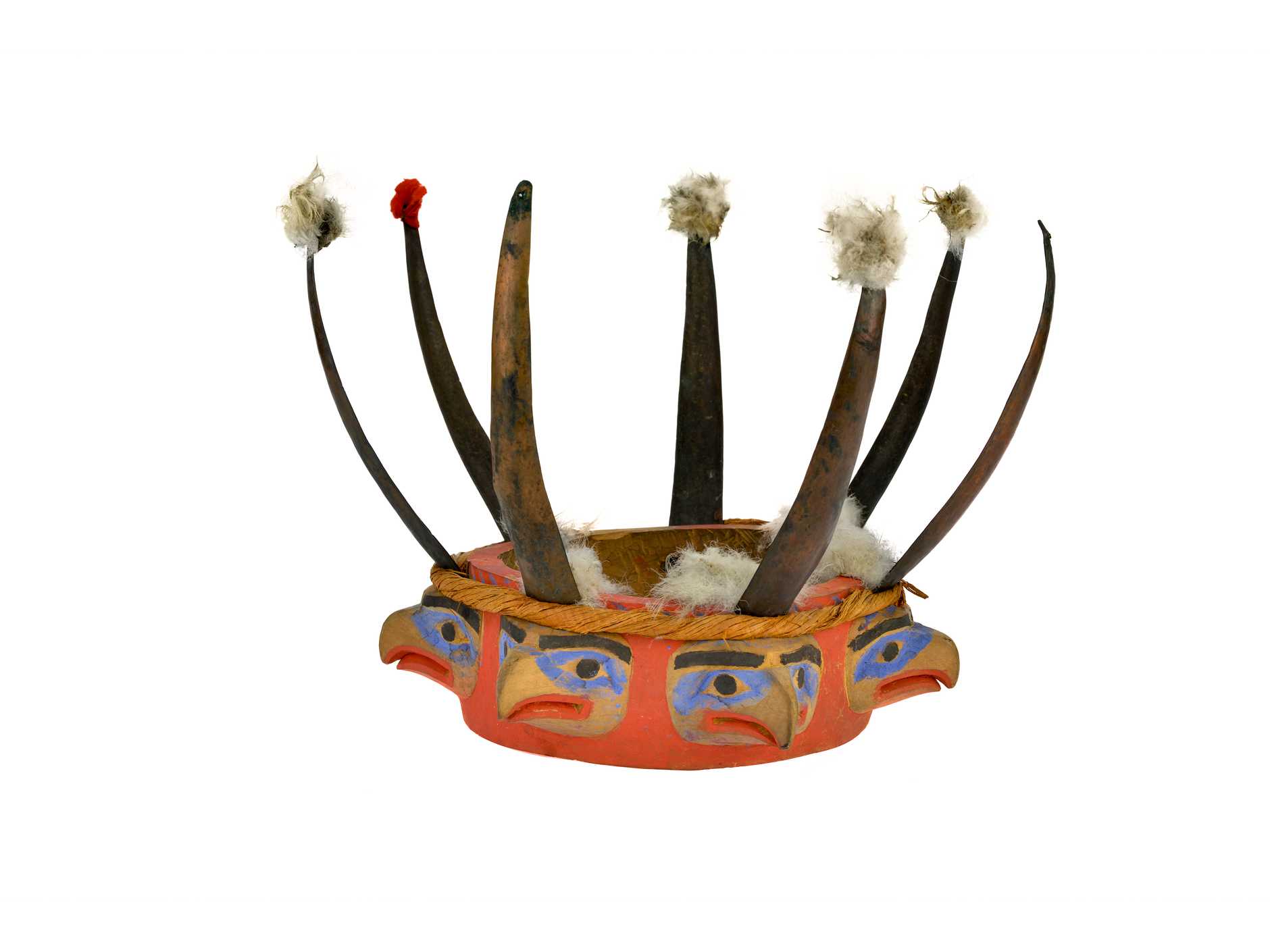
Ts’lkt | Eagle headdress When a Nuxalk man marries, his wife’s treasures—songs, dances, stories, family crests, and the rights they entail—are “dragged across” to her new home. In this way, designs and ideas may travel widely. This crown-like headdress resembles those worn to the north of Nuxalk lands. The design may have been brought by a high-ranking woman who married into a Nuxalk family.
AMNH Anthropology 16/1519
Syut | Supernatural Beings
Nuxalk family origin stories tell of the first people to settle the world and their extraordinary adventures. In some accounts, an Ancestor journeys to Nuyaltwa, the undersea world, encountering supernatural beings with marvelous treasure. Q’umakwa, Chief of the sea, lives in a house made of copper and rules over every living thing in the ocean. During ceremonies of the Sisawk society, masked dancers dazzle guests with the splendor of Q’umakwa and other wonders.
Stories describe the undersea world as a broad, prairie-like flatland, with a large river winding through it. Q’umakwa lives at the river’s mouth. Nuxalk people prize salmon and berries as gifts from Q’umakwa.
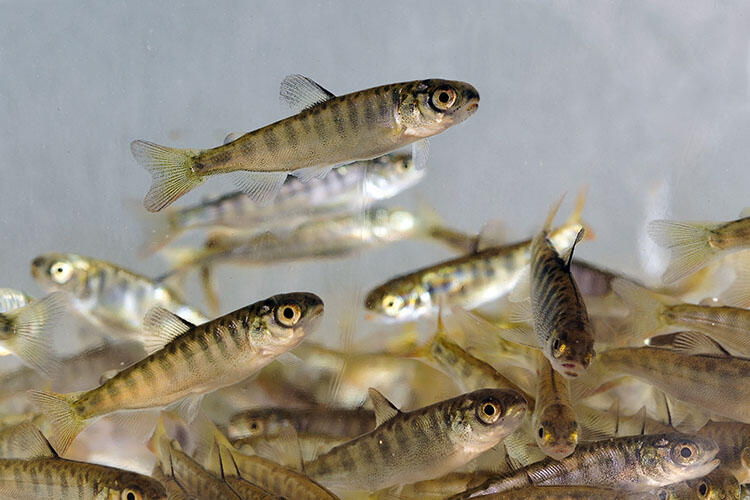 Upriver, the different species of fish live as people do, in their own towns.
Upriver, the different species of fish live as people do, in their own towns.Michael Wigle
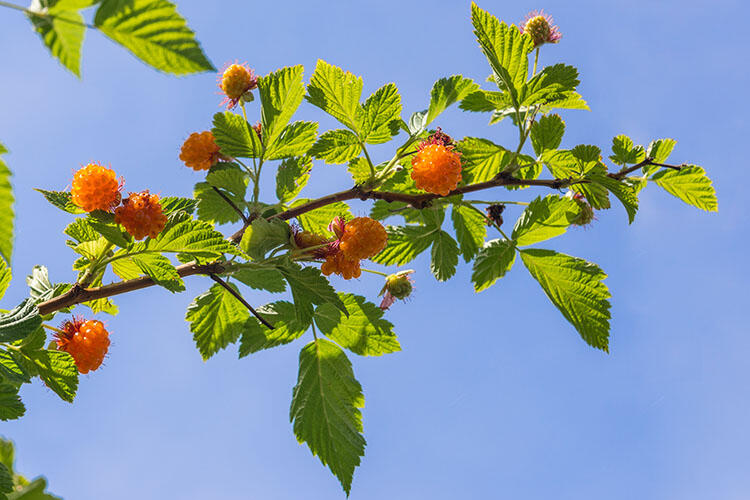 At the headwaters of the river is a mountain range where the berries have their homes.
At the headwaters of the river is a mountain range where the berries have their homes.Shutterstock
Q’umakwa, Chief of the sea, and his wife, Talyu, are said to live in an undersea house near Miaysila | Tallio Point, southwest of Bella Coola. Here, glacial water mixes with saltwater, forming streams of different colors, said to be Talyu’s hair.
John Zada/Alamy
Q’umakwa is part of the traditions and culture in Kimsquit. He’s the king of the underwater world, and he looks after everything in the ocean. My grandmother, Dr. Margaret Siwallace, was a Chief of Kimsquit, and she gave that name Q’umakwa to my youngest son, Russell.
- Wits’lks | Peter Siwallace, Hereditary Chief
Nuxalk Nation, Bella Coola, British Columbia
Smayusta | Origins
The story of the Nuxalk people begins with Alhkw’ntam, the Maker of All Things, who steers the Sun and presides over all. At the beginning of time, Alhkw’ntam created Masmasalaniixw, the Four Supernatural Carpenters, and directed them to carve the first human beings. The Carpenters also made all plants, animals, and features of Earth. They made language to communicate, houses to sleep in, and equipment for harvesting food. Provided with these gifts, the people established themselves on Earth, forming the first Nuxalk families.
Denis Finnin/Anthropology catalog 16/1507
Contemporary Carvers and Carpentry
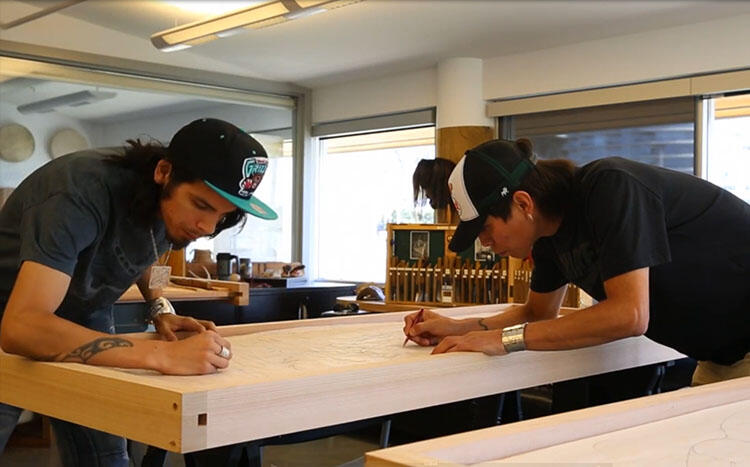 From the time of the Four Carpenters who created the world, Nuxalk families have passed down and expanded the art of working wood.
From the time of the Four Carpenters who created the world, Nuxalk families have passed down and expanded the art of working wood.Emily Carr/University of Art + Design
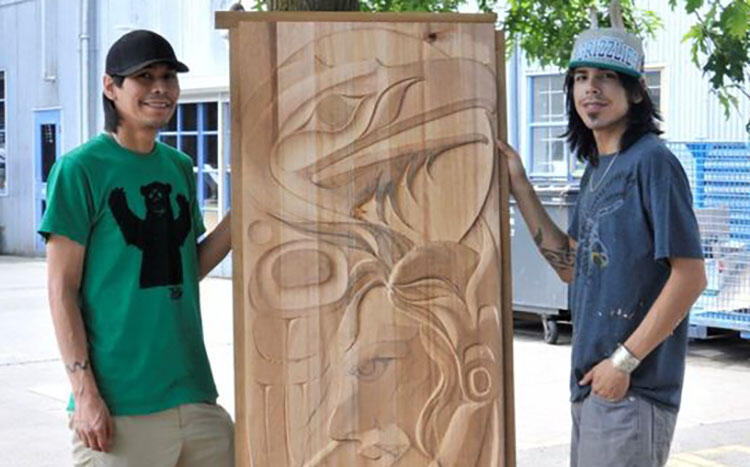 In 2015, Nunuusxli | Chazz Mack and Wiiqa7ay | Lyle Mack, two of the Nation’s most talented carvers, created a design representing the story of Raven and Sockeye Salmon Woman, which they carved on a wooden door.
In 2015, Nunuusxli | Chazz Mack and Wiiqa7ay | Lyle Mack, two of the Nation’s most talented carvers, created a design representing the story of Raven and Sockeye Salmon Woman, which they carved on a wooden door.Coastal Art Beat
In the Nuxalk Nation Carpentry Program, apprentices receive on-the-job training to become certified carpenters.
[Newly constructed homes in a valley. Carpenters cut wood]
JALISSA MOODY (Former Assistant Asset Manager, Nuxalk Nation): The carpentry program in Bella Coola was started several years ago now and it's a partnership with Camousun College and they brought carpenters and training carpenters within the community.
CARRIGAN TALLIO (Assistant Asset Manager, Nuxalk Nation): For a number of years we had no development at all.
RICHARD HALL (Former Asset Manager, Nuxalk Nation): We had really a shortfall of housing and people working. And then I designed the program to create employment, build capacity, and utilize what resources we have.
[Carpenters make measurements, cut wood, and work on a house.]
[ON-SCREEN TEXT: Apprentices will gain practical experiences working on projects to gain them the hours to become a certified carpenter.]
RICHARD HALL: Year One they’re starting the basic layout, basic framing, basic elevations, doing some footings and foundations. Starting to build the structure.
KESHIA SCHOONER (Apprentice): My first year, I was just interested. I didn't even have any experience. It’s kind of developed each year I've taken, and I'm really looking forward to fourth year. I've always been like a hands-on person. Being able to go to school and use those skills and I have my own home. It's not complete yet, but you know, I'm now gaining the skills to where I would be able to do that.
[Carrigan Tallio driving.]
CARRIGAN TALLIO: This new road that I'm gonna bring you down is- this was just all trees.
[Interiors and exteriors of new buildings. A site being readied for construction.]
JALISSA MOODY: Within the past three years we've built a restaurant, we've built seven new cabins that are run by the Nation, and we have done two new triplexes, and we are currently starting on a fiveplex and a triplex.
[ON-SCREEN TEXT: With increased housing in the Nuxalk Nation, many members are returning home to give back to their community.]
[Flyover of the village, surrounded by mountains.]
CARRIGAN TALLIO: Growing up it was really hard to imagine myself, like, living on Reserve because, you know, you just never really got to see the growth.
[Carrigan and Vance review elevation plans.]
VANCE SNOW (Asset Manager, Nuxalk Nation}: Now, we’re just going to be building every year. So, there'll be like a sustainability for housing, more housing coming up in the future.
[Landscapes and new buildings.]
RICHARD HALL: I want the people to know that what they have there they should be proud of, that they are- they're doing the building. Nobody else is doing the building. I want them to take pride and pass the torch to the youth.
JALISSA MOODY: I'm so happy that I had the opportunity to be a part of this incredible team and that team was able to build homes to bring our people home. Me being one of them!
[ON-SCREEN TEXT: The carpentry program also adapts to the local climate to improve the durability and efficiency of the homes they build.]
Klhtim Wa Tl’msta Ts | Coming To Earth
Nuxalk people trace their way of life to the beginning of time, when Alhkw’ntam and his Four Supernatural Carpenters created plants, animals and all the features of the world. At the time of creation, each animal was given tools needed to make a living, such as sharp teeth, strong talons, or keen eyes. The first Ancestors of the Nuxalk people, too, were sent to Earth with tools needed to harvest food and construct their homes.
Eulachon, small fish that are prized for the nutritious oil they release when boiled, return to certain rivers on the Northwest Coast to spawn each year. Millions of eulachon once migrated up the Bella Coola River, but in the late 1990s, the population collapsed.
Michael Wigle
Eulachon are endangered by rising water temperatures and commercial shrimp trawlers that catch and discard many tons of fish and other sea life. At the Nuxalk Fisheries and Wildlife laboratory, members of the Nuxalk community are monitoring spawning areas to aid their recovery.
Every year we’re in the river in March and April to monitor how many eulachon are coming back to spawn. You have to work with the tides, you have to be out in the dark or if it’s snowing or raining, you’re in boots or in rain gear—you really have to be motivated to do that type of work.
— Sq’mlhh | Jason Moody, Fisheries and Wildlife Program Coordinator
Nuxalk Nation, Bela Coola, British Columbia
Louvens Rémy
For generations, Nuxalk people cultivated plants with edible roots along the edges of saaxwan, or tidal estuaries. With a digging stick—a versatile tool—caretakers weeded out grasses and turned the soil to encourage these plants to thrive. In autumn, gardeners harvested the roots to be roasted or steamed.
Nancy J. Turner
Nancy J. Turner
Dr. David Wartinbee/Redoubt Reporter
S7ayulh | Thunder Dance
In the Thunder Dance, a Nuxalk dancer dazzles spectators with the feats of Thunder, one of the mightiest and most respected supernatural beings. An entourage of supernatural dancers attends the ceremony, and each is invited to perform in turn. The Thunder Dance commemorates a dramatic event experienced long ago by four Nuxalk brothers, in which Thunder came booming down from the upper realm, clutching a quartz crystal and dancing on rainbows from one mountaintop to the next.
Nuxalk people have kept the spectacular Thunder Dance alive through some of the darkest times in their history. In the 1860s, dancers passed the tradition on even as smallpox swept into their territories, taking many hundreds of lives. When Canada banned Native ceremonies, from 1884 to 1951, Thunder dancers continued to perform in secret.
Although many dances of the Northwest Coast are widely shared, Thunder belongs to Nuxalk people alone, and only members of the Kusyut society may be initiated into the dance.
S7ayulhus | Thunder mask
Wearing a heavy mask (below) and an apron laden with sound makers, Thunder stands tall, then leaps and falls to his knees, dancing with great agility and strength. Thunder has a beak-like nose and bulging forehead, as described by an Ancestor who witnessed this supernatural being. This mask was inset with mirrors and rubbed with graphite to reflect light from the fire. Before performing, the dancer trimmed it with branches sprinkled with eagle down, to represent lightning.
Click on the 3D model below for a closer look.
Raven Stories
On the Northwest Coast, some stories are family treasures and may only be told with the owner’s consent. Others are public, told for entertainment and education and shared across many Nations.
Some of the best-known public stories describe the adventures of Raven, known in the Nuxalk language as Qwaxw. This mythic being is said to have lived long ago, when the world was new and still in the process of transformation. Raven fixed many things for the first Ancestors and is often called the Re-creator. Depending on the story, Raven can appear in bird or human form, or in the guise of another creature.
Matt Shanley/©AMNH, AMNH Anthropology 16.1/554 B
Matt Shanley/© AMNH
Matt Shanley/© AMNH
Nuxalk Radio
Nuxalk Radio 91.1 FM (Bella Coola) is a radio station built to help keep the Nuxalkmc language alive and broadcast the laws of the lands and waters.
When we opened Nuxalk Radio, we had all of our hereditary chiefs there to bless it, to legalize it in our own tradition and that was a good step because now, we’re seeing more and more of our community returning towards calling on our hereditary chiefs to guide us and to validate the work that we’re doing.
—Snxakila Clyde Michael Tallio, Alkw | Ceremonial Speaker
Nuxalk Nation, Bella Coola, British Columbia
Nuxalk filmmaker Banchi Hanuse wrote and directed Nuxalk Radio, a three-minute documentary about the station produced by Lantern Films, which premiered in 2020. Following are some stills from the film.
Banchi Hanuse, Director & Writer; Produced by Lantern Films
Banchi Hanuse, Director & Writer; Produced by Lantern Films
Banchi Hanuse, Director & Writer; Produced by Lantern Films
Banchi Hanuse, Director & Writer; Produced by Lantern Films
Banchi Hanuse, Director & Writer; Produced by Lantern Films
Banchi Hanuse, Director & Writer; Produced by Lantern Films
More Resources
Nuxalk Consulting Curator
Snxakila Clyde Michael Tallio